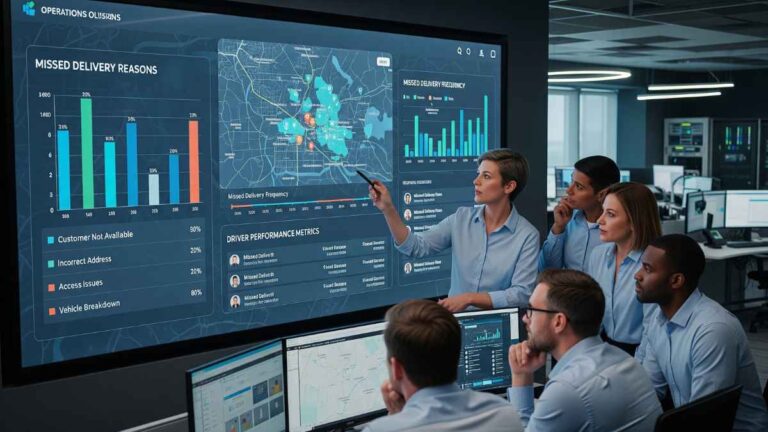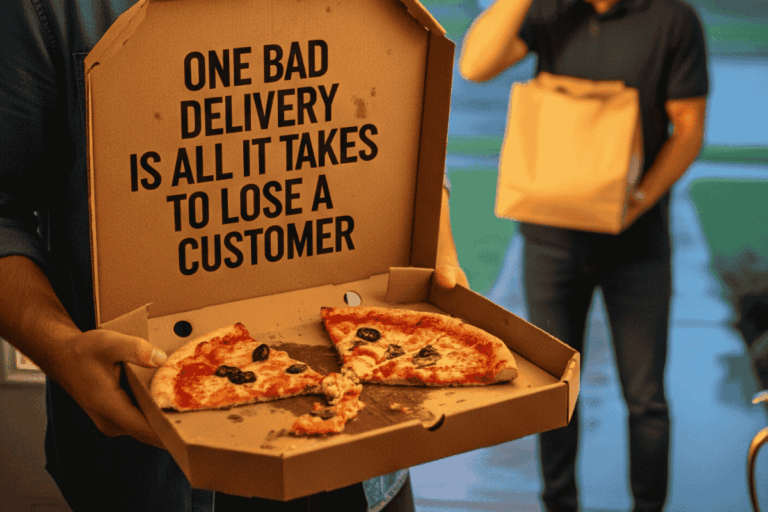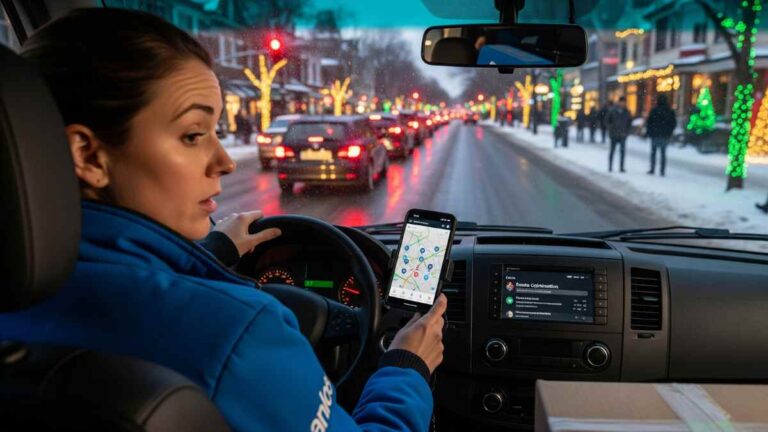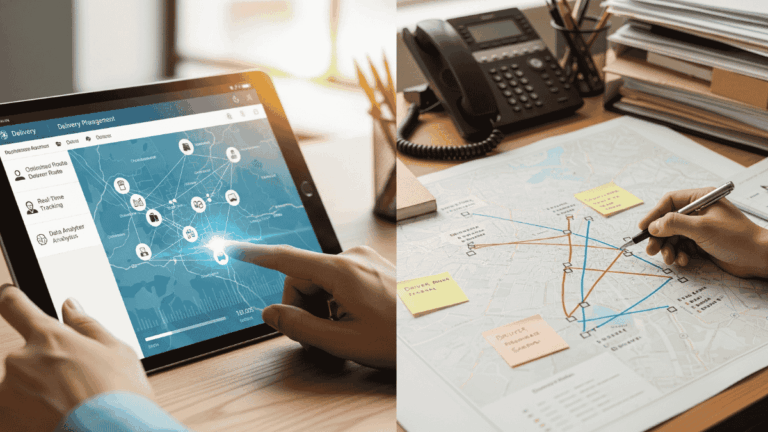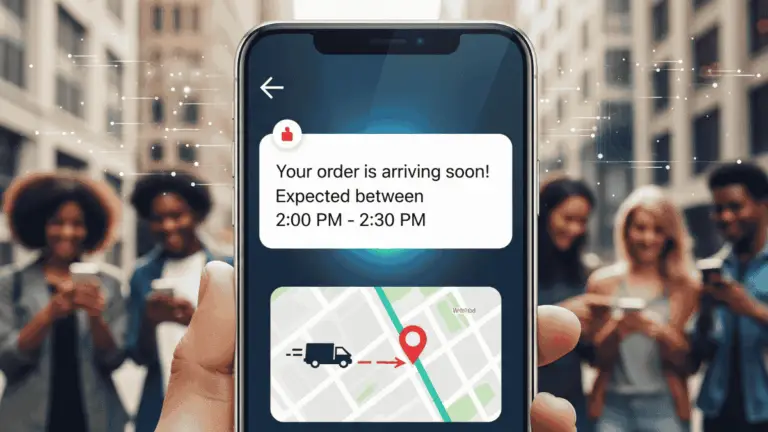Imagine a delivery company that receives hundreds of dispatches weekly. The company needs to use effective route planning to measure distances accurately and find the best route for each delivery, ensuring that each order arrives promptly at a customer’s door. Getting your fleet management down to a tee will help your company deliver quickly and satisfy customers.
Here’s what you need to know to get you on the right road to delivering items efficiently and fast.
What do you mean by route planning?
Route planning is a critical process in logistics and delivery services that involves using a route planner to determine the most efficient path for vehicles to travel to deliver goods or services to multiple destinations.
An essential tool in this process is the journey planner, an interactive online mapping service for heavy vehicles provided by NHVR, which helps users plan routes and identify where access permit applications may be required.
Proper route planning considers various factors to optimize the delivery process, reducing travel time, fuel consumption, and operational costs while ensuring timely and accurate deliveries.
Benefits of route planning
Cost savings
Every business has to watch the numbers. Route planning will help shorten travel times and lower fuel consumption – you save on fuel costs. Route planning tools measure distances to optimize routes and reduce fuel consumption. For instance, a company can significantly reduce fuel expenses by optimizing routes to reduce unnecessary mileage.
Additionally, the ability to split routes for better organization and management can further enhance efficiency and cost savings.
Furthermore, efficient routing minimizes vehicle wear and tear, reducing maintenance costs over time.
Improved delivery times
Your driver or dispatch manager’s favorite route may not be the best option. Route optimization puts your driver on the fastest route, avoiding traffic during parcel delivery. Route planning tools provide turn-by-turn directions to ensure timely deliveries. This ensures that deliveries are made promptly, enhancing customer satisfaction.
With advanced route planning software, delivery companies can dynamically adjust routes in real-time based on traffic conditions, accidents, or road closures, ensuring the fastest and most efficient path is always chosen.
Competitive advantage
Your competitor down the road is still stuck in the dark ages with spreadsheets. His customer reviews are not great. Your customers are raving about your fast delivery and see you as highly reliable because you’ve prioritized route mapping.
In today’s fast-paced world, customers expect quick and reliable service. Companies that invest in sophisticated route planning technology stand out from the competition by consistently meeting and exceeding delivery expectations.
Better resource management
Route planning helps your delivery company better utilize delivery vehicles. By having enough vehicles to courier items, you won’t be stuck in the slow lane. Efficient route planning allows for better resource allocation, ensuring that vehicles and drivers are used to their full potential.
This not only improves overall efficiency but also reduces operational costs by minimizing the need for extra vehicles or overtime work.
Enhanced customer satisfaction
Customers today want fast, reliable, and transparent delivery services. Route planning plays an important role in meeting these expectations. Customers can benefit from saved routes for future reference and repeat deliveries. By ensuring timely deliveries, providing accurate estimated times of arrival (ETAs), and offering real-time tracking, businesses can significantly enhance the customer experience.
Satisfied customers are more likely to become repeat customers and recommend the service to others, increasing business and brand loyalty.
Real-time updates
One significant advantage of modern route planning systems is the ability to provide real-time updates. This means that the system can immediately adjust the route to avoid delays if there are any changes in traffic conditions, accidents, or other unforeseen events.
For instance, if a major traffic delay occurs on the original route, the software can reroute the driver to a different route, ensuring timely delivery. This not only improves efficiency but also enhances the reliability of the delivery service.
Accurate arrival times
Providing customers with accurate estimated times of arrival (ETAs) is crucial for managing expectations and improving satisfaction. With sophisticated route planning tools, companies can offer precise ETAs based on real-time data and historical traffic patterns.
This transparency allows customers to plan their day better, reducing frustration and increasing trust in the delivery service.
Proof of Delivery
Proof of delivery (POD) is an essential feature for both customers and businesses. It provides confirmation that a package has been delivered to the correct recipient at the specified location and time.
Advanced route planning systems often integrate POD, allowing drivers to capture signatures, photos, or other forms of confirmation through mobile devices. This not only ensures accountability but also helps resolve any disputes that may arise regarding delivery status.
Environmental benefits
In addition to cost savings and improved efficiency, optimized route planning also offers significant environmental benefits. By reducing unnecessary mileage and optimizing routes, companies can lower their carbon footprint.
his is particularly important in today’s world, where consumers are increasingly conscious of the environmental impact of their purchases. By promoting sustainable delivery practices, businesses can attract environmentally conscious customers and contribute to a greener planet.
Integration with other systems
Modern route planning software often integrates seamlessly with other business systems, such as inventory management, customer relationship management (CRM), and order processing.
This integration allows for a more streamlined and efficient workflow, reducing the risk of errors and improving overall operational efficiency.
For instance, when an order is placed, the system can automatically update the route plan and provide the driver with the necessary information, ensuring a smooth and efficient delivery process.

The role of technology in providing route directions
The advancements in technology have revolutionized route planning for delivery services. Here are some of the key technological innovations driving this transformation:
Artificial intelligence and machine learning
Artificial intelligence (AI) and machine learning algorithms are increasingly being used to optimize route planning.
These technologies can analyze vast amounts of data, including historical traffic patterns, weather conditions, and delivery time windows, to generate the most efficient routes.
Machine learning algorithms can continuously learn and improve from past data, making the route planning process more accurate and efficient over time.
GPS and real-time traffic data
GPS technology and real-time traffic data are fundamental components of modern route planning systems. They provide accurate and up-to-date information about the current state of the roads, allowing for dynamic route adjustments. GPS technology helps in displaying routes on a map for better navigation.
This ensures that drivers are always on the best possible route, avoiding delays and reducing delivery times.
Mobile apps and driver communication
Mobile apps have become an essential tool for drivers, providing them with real-time route information, traffic updates, and delivery instructions. These apps also provide maps for drivers to follow during deliveries.
These apps also facilitate communication between drivers and dispatchers, allowing for quick resolution of any issues that may arise during the delivery process. Mobile apps can optimize routes with multiple stops to save time and fuel.
Additionally, mobile apps can capture proof of delivery and customer feedback, further enhancing the efficiency and reliability of the service.
Internet of Things (IoT)
The Internet of Things (IoT) has enabled the development of smart delivery vehicles equipped with sensors and connected devices. These vehicles can collect and transmit data in real-time, providing valuable insights into vehicle performance, traffic conditions, and delivery status.
IoT technology can also be used to monitor the condition of perishable goods during transit, ensuring that they are delivered in optimal condition.

The economic impact of route planning
Fuel efficiency and cost reduction
Fuel is one of the largest expenses for delivery companies. Route planning can significantly reduce fuel consumption by minimizing unnecessary driving and ensuring that vehicles take the most efficient routes. Route planning tools help in finding the quickest route to reduce fuel consumption.
This not only lowers operational costs but also contributes to environmental sustainability by reducing greenhouse gas emissions.
For example, UPS’s ORION (On-Road Integrated Optimization and Navigation) system reportedly saves the company millions of gallons of fuel annually through optimized routing.
Reducing overtime and operational costs
Effective route planning helps in reducing the need for overtime by ensuring that drivers can complete their deliveries within their scheduled shifts. This improves overall operational efficiency and reduces labor costs.
Additionally, by optimizing routes, companies can minimize vehicle wear and tear, leading to lower maintenance expenses and extending the lifespan of their fleet.
What are the challenges in planning multiple routes?
While route planning offers numerous benefits, it also presents several challenges that delivery companies need to address:
Traffic congestion
Traffic congestion remains one of the biggest challenges for delivery services, particularly in urban areas. Despite advanced route planning systems, unpredictable traffic patterns can still cause delays. Adjusting the start point of a route can help in avoiding traffic congestion.
To mitigate this, companies need to continuously monitor traffic conditions and be prepared to make real-time adjustments to routes.
Regulatory and compliance issues
Different regions may have varying regulations and compliance requirements that impact delivery operations.
For example, certain areas may have restrictions on delivery times, vehicle sizes, or emissions. Delivery companies need to stay informed about these regulations and ensure that their route planning processes comply with all relevant laws.
Customer expectations
Customer expectations for fast and reliable delivery continue to rise. Meeting these expectations requires continuous investment in technology and process improvements.
Companies must also effectively communicate with customers to manage expectations and provide accurate delivery updates.
Driver shortages
The logistics industry is facing a shortage of qualified drivers, which can impact delivery efficiency. Effective route planning can help mitigate this issue by optimizing the use of available drivers and reducing the overall number of trips required.
However, companies also need to invest in driver recruitment, training, and retention to ensure a sufficient workforce.
Future trends in route planning
The future of route planning is likely to be shaped by several emerging trends and technologies:
Autonomous vehicles
Autonomous delivery vehicles have the potential to revolutionize the logistics industry by significantly reducing labor costs and improving efficiency. Future journey planners will integrate autonomous vehicles for more efficient route planning.
While fully autonomous delivery is still in the experimental stage, several companies are already testing self-driving vehicles for last-mile delivery. As this technology matures, it is expected to play a major role in route planning and execution.
The integration of journey planners with autonomous vehicles will further enhance route optimization and efficiency.
Drones and aerial delivery
Drones offer a promising solution for overcoming traffic congestion and reaching remote or hard-to-access areas.
Several companies are already experimenting with drone delivery for small parcels. In the future, drones could become a standard component of the delivery network, providing fast and efficient service for certain types of deliveries.
Blockchain technology
What is blockchain? Blockchain is a decentralized and secure digital ledger technology that records transactions across multiple computers, ensuring data transparency, immutability, and security.
Blockchain technology can enhance transparency and security in the delivery process by providing an immutable record of all transactions and deliveries.
This can help prevent fraud, ensure accountability, and improve trust between all parties involved. Additionally, smart contracts on the blockchain can automate various aspects of the delivery process, further enhancing efficiency.
Predictive analytics
Predictive analytics uses historical data and machine learning algorithms to forecast future events and trends.
In the context of route planning, predictive analytics can help companies anticipate traffic patterns, weather conditions, and customer demand, allowing for more proactive and efficient route planning.
Best practices for implementing the best route planning
Invest in advanced technology
To fully reap the benefits of route planning, companies need to invest in advanced technology. This investment can provide a first-class delivery experience. This includes GPS systems, route optimization software, and mobile apps for drivers. By leveraging the latest technology, companies can improve efficiency, reduce costs, and enhance customer satisfaction.
Train drivers and dispatchers
Effective route planning is not just about technology; it also requires skilled drivers and dispatchers.
Companies should invest in training programs to ensure that their staff are proficient in using route planning tools and can make informed decisions on the road. Regular training and updates can help keep the team up-to-date with the latest best practices and technologies.
Monitor and analyze performance
Continuous monitoring and analysis of route planning performance are crucial for ongoing improvement. Companies should regularly review their delivery metrics, such as on-time delivery rates, fuel consumption, and customer satisfaction.
By analyzing this data, they can identify areas for improvement and make necessary adjustments to their route planning strategies.
Focus on customer communication
Transparent communication with customers is key to managing expectations and enhancing satisfaction. Companies should provide accurate ETAs, real-time tracking, and timely updates on any changes or delays. This transparency helps build trust and ensures a positive customer experience.

Conclusion
Effective route planning is crucial for the success of delivery services in today’s fast-paced and competitive market. By optimizing routes, companies can achieve significant cost savings, improve delivery times, enhance customer satisfaction, and gain a competitive edge.
The integration of advanced technologies such as AI, IoT, and blockchain is further transforming the route planning landscape, offering new opportunities for efficiency and innovation.
However, delivery companies must also navigate various challenges, including traffic congestion, regulatory compliance, and driver shortages. By staying informed about industry trends and continuously investing in technology and process improvements, companies can overcome these challenges and ensure a smooth and efficient delivery process.
As the logistics industry continues to evolve, route planning will remain a critical component of successful delivery operations.
Photo Credits: Canva
About the author
Sharl is a qualified journalist. He has over 10 years’ experience in the media industry, including positions as an editor of a magazine and Business Editor of a daily newspaper. Sharl also has experience in logistics specifically operations, where he worked with global food aid organisations distributing food into Africa. Sharl enjoys writing business stories and human interest pieces.




